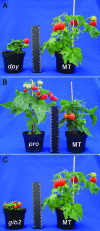Small and remarkable: The Micro-Tom model system as a tool to discover novel hormonal functions and interactions
- PMID: 20037476
- PMCID: PMC2881274
- DOI: 10.4161/psb.5.3.10622
Small and remarkable: The Micro-Tom model system as a tool to discover novel hormonal functions and interactions
Abstract
Hormones are molecules involved in virtually every step of plant development and studies in this field have been shaping plant physiology for more than a century. The model plant Arabidopsis thaliana, long used as a tool to study plant hormones, lacks significant important developmental traits, such as fleshy climacteric fruit, compound leaf and multicellular trichomes, suggesting the necessity for alternative plant models. An attractive option often used is tomato, a species also of major economic importance, being ideal to bring together basic and applied plant sciences. The tomato Micro-Tom (MT) cultivar makes it possible to combine the direct benefits of studying a crop species with the fast life cycle and small size required for a suitable biological model. However, few obscure questions are constantly addressed to MT, creating a process herein called "MT mystification". In this work we present evidence clarifying these questions and show the potential of MT, aiming to demystify it. To corroborate our ideas we showed that, by making use of MT, our laboratory demonstrated straightforwardly new hormonal functions and also characterized a novel antagonistic hormonal interaction between jasmonates and brassinosteroids in the formation of anti-herbivory traits in tomato.
Figures
Comment on
-
Brassinosteroids interact negatively with jasmonates in the formation of anti-herbivory traits in tomato.J Exp Bot. 2009;60(15):4347-61. doi: 10.1093/jxb/erp270. Epub 2009 Sep 4. J Exp Bot. 2009. PMID: 19734261
Similar articles
-
Convergence of developmental mutants into a single tomato model system: 'Micro-Tom' as an effective toolkit for plant development research.Plant Methods. 2011 Jun 29;7(1):18. doi: 10.1186/1746-4811-7-18. Plant Methods. 2011. PMID: 21714900 Free PMC article.
-
Transcriptome data for tissue-specific genes in four reproductive organs at three developmental stages of micro-tom tomato.Data Brief. 2021 Jan 8;34:106715. doi: 10.1016/j.dib.2021.106715. eCollection 2021 Feb. Data Brief. 2021. PMID: 33506081 Free PMC article.
-
Selection of Reference Genes for Quantitative Real-Time RT-PCR Studies in Tomato Fruit of the Genotype MT-Rg1.Front Plant Sci. 2016 Sep 13;7:1386. doi: 10.3389/fpls.2016.01386. eCollection 2016. Front Plant Sci. 2016. PMID: 27679646 Free PMC article.
-
Complex Interplay of Hormonal Signals during Grape Berry Ripening.Molecules. 2015 May 21;20(5):9326-43. doi: 10.3390/molecules20059326. Molecules. 2015. PMID: 26007186 Free PMC article. Review.
-
Rosaceae Fruit Development, Ripening and Post-harvest: An Epigenetic Perspective.Front Plant Sci. 2017 Jul 17;8:1247. doi: 10.3389/fpls.2017.01247. eCollection 2017. Front Plant Sci. 2017. PMID: 28769956 Free PMC article. Review.
Cited by
-
Phytochrome-Dependent Temperature Perception Modulates Isoprenoid Metabolism.Plant Physiol. 2020 Jul;183(3):869-882. doi: 10.1104/pp.20.00019. Epub 2020 May 14. Plant Physiol. 2020. PMID: 32409479 Free PMC article.
-
Promoter replacement of ANT1 induces anthocyanin accumulation and triggers the shade avoidance response through developmental, physiological and metabolic reprogramming in tomato.Hortic Res. 2022 Nov 15;10(2):uhac254. doi: 10.1093/hr/uhac254. eCollection 2023 Feb. Hortic Res. 2022. PMID: 36751272 Free PMC article.
-
SELF-PRUNING Acts Synergistically with DIAGEOTROPICA to Guide Auxin Responses and Proper Growth Form.Plant Physiol. 2018 Apr;176(4):2904-2916. doi: 10.1104/pp.18.00038. Epub 2018 Mar 2. Plant Physiol. 2018. PMID: 29500181 Free PMC article.
-
Convergence of developmental mutants into a single tomato model system: 'Micro-Tom' as an effective toolkit for plant development research.Plant Methods. 2011 Jun 29;7(1):18. doi: 10.1186/1746-4811-7-18. Plant Methods. 2011. PMID: 21714900 Free PMC article.
-
Inhibition of auxin transport from the ovary or from the apical shoot induces parthenocarpic fruit-set in tomato mediated by gibberellins.Plant Physiol. 2010 Jun;153(2):851-62. doi: 10.1104/pp.110.155424. Epub 2010 Apr 13. Plant Physiol. 2010. PMID: 20388661 Free PMC article.
References
-
- Darwin C, Darwin G. The power of movement in plants. New York, USA: Appleton-Century Inc; 1880.
-
- Umehara M, Hanada A, Yoshida S, Akiyama K, Arite T, Takeda-Kamiya, et al. Inhibition of shoot branching by new terpenoid plant hormones. Nature. 2008;455:195–200. - PubMed
-
- Davies PJ. Plant hormones: biosynthesis, signal transduction, action! Dordrecht, Netherlands: Kluwer Academics Publisher; 2004.
-
- Pnueli L, Carmel-Goren L, Hareven D, Gutfinger T, Alvarez J, Ganal M, et al. The SELF-PRUNING gene of tomato regulates vegetative to reproductive switching of sympodial meristems and is the ortholog of CEN and TFL1. Development. 1998;125:1979–1989. - PubMed
Publication types
LinkOut - more resources
Full Text Sources
Other Literature Sources

